Dubai: Hotels in the UAE saw the average daily rate (ADR) rise 4.2 per cent to Dh544 year-on-year in July even as occupancy fell 7.9 per cent to 46 per cent, according to a report by research firm STR Global.
Revenue per available room (RevPAR) — a performance benchmark — dropped 4 per cent to Dh250.
Meanwhile in the Middle East and Africa, hotels posted a 0.9 per cent increase in occupancy levels to 49.3 per cent, while ADR rose 6.9 per cent to $156.50 (Dh574.8). As a result, RevPAR grew by 7.9 per cent to $77.
“On a 12-month-moving-average basis, supply and demand growth are on par at 2.8 per cent, which means occupancy growth is flat, at 61.4 per cent. Ramadan occurred entirely in July which resulted in lower-than-usual levels of demand in what is typically the region’s weakest month of the year. The confluence of these factors resulted in lower than average performance for the month,” stated Elizabeth Winkle, managing director of STR Global. She expects performance to pick up in August.
Egyptian capital Cairo and South Africa’s Cape Town recorded the largest hotel occupancy increases during July, with a growth of 73.9 per cent to 29.3 per cent and 15.8 per cent to 52.4 per cent, respectively. Meanwhile, Amman, Jordan, and Kenyan capital Nairobi posted the largest occupancy decreases, falling 20.2 per cent to 34.4 per cent and 16 per cent to 55.3 per cent, respectively.
Saudi Arabian city Jeddah was the only market in the region to record double-digit growth in ADR in July, which was up 12.5 per cent to $286.
In terms of RevPAR, three markets recorded increases in that metric of more than 15 per cent, including Cairo ($30.57), Manama ($72.94) and Cape Town ($49.76). Amman hotels, meanwhile, had the largest decrease in that metric, down 21.4 per cent to $54.86.












